LAB REPORT
Science and Technology Making Headlines
Dec. 22, 2017

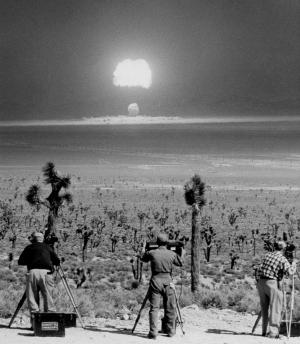
Operation Teapot is just one of the newly declassified videos of a nuclear blast now available on YouTube.
It’s explosive
Newly declassified videos show never-before-seen footage of nuclear missile tests conducted by the U.S. during the Cold War.
Researchers at Lawrence Livermore National Laboratory released 62 new videos that show tests of atmospheric nuclear testing during the 1950s and 1960s, when the U.S. was entrenched in an ongoing conflict with the Soviet Union.
“We’ve received a lot of demand for these videos and the public has a right to see this footage,” said LLNL nuclear weapons physicist Gregg Spriggs. “Not only are we preserving history, but we’re getting much more consistent answers with our calculations."


Lawrence Livermore National Laboratory researchers Heather Enright (left) and Anna Belle hold the brain-on-a-chip device and a microelectrode array.
Chipping at the brain
Lawrence Livermore scientists and engineers have developed a “brain-on-a-chip” device aimed at testing and predicting the effects of biological and chemical agents, disease or pharmaceutical drugs on the brain over time without the need for human or animal subjects.
The device, part of the Lab’s iCHIP (in-vitro Chip-Based Human Investigational Platform) project, simulates the central nervous system by recording neural activity from multiple brain cell types deposited and grown onto microelectrode arrays. The platform could help scientists understand how brain cells connect and interact, combat brain disorders, determine how soldiers are affected by exposure to chemical and biological weapons, and develop antidotes to counteract those effects.
Scientists said the platform is part of LLNL’s broader vision for countering emerging and existing threats, allows them to study the networks formed among various regions of the brain, and obtain timely, human-relevant data without animal or human testing. The data would be used to better predict human response to countermeasures, viruses or pharmaceutical drugs, and could help scientists determine if certain types of neurons are more susceptible to exposure.

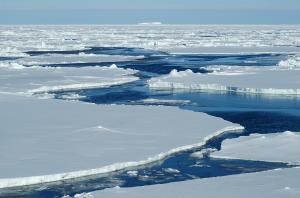
New LLNL research shows the loss of Arctic sea ice could spur more frequent droughts in California.
Rain, rain went away
At the beginning of December, a huge high-pressure ridge parked off the Pacific coast, and created the perfect conditions for a strong Southern California outflow of Santa Ana dry winds that fed many wildfires in the region.
This powerful high-pressure ridge is predicted to occur more frequently in the future. According to research from Lawrence Livermore National Laboratory, vanishing Arctic sea ice could drive future California Pacific ridges, spurring more droughts, which in turn result in statewide firestorms.
Sea ice loss in the Arctic will push precipitation that historically headed to California and send it to Canada and Alaska. By altering convection patterns over the tropical Pacific, the loss of sea ice will drive the formation of an atmospheric ridge in the North Pacific. In coming years, this could magnify the effect of the state's recent lack of precipitation. "On average, when considering the 20-year mean, we find a 10-15 percent decrease in California's rainfall," said LLNL’s Ivana Cvijanovic, the lead researcher.

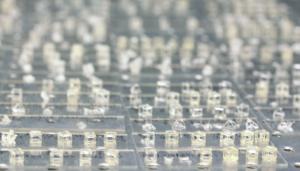
LLNL researchers have created a 3D printing technique that produces objects faster by using laser holograms.
3D printing gets a move on
3D printers often take their sweet time to print something. Large objects can take several hours to make it from desktops onto the print bed. Until now. A team of researchers, led by Lawrence Livermore National Laboratory, think they’ve found a better, much faster way and it involves using laser holograms.
Instead of the classic method of printing an object by putting down one layer at a time, the team’s new “holographic” printing technique utilizes special resins that solidify as soon as they are exposed to light. By shining three laser beams simultaneously at a vat filled with the resin, the researchers have showcased the ability to fabricate a 3D structure in only 10 seconds.
LLNL’s Maxim Shusteff said the technique can improve on existing 3D printing because it won’t create the same layering-based defects, such as zigzag or step-style surfaces, that come with regular additive manufacturing. “Although our parts aren’t particularly smooth yet, we’ve broken the conceptual barrier for how to get there,” Shusteff said. “I don’t think this will make other ways of doing additive manufacturing obsolete, but it adds a powerful new tool to the broad additive manufacturing toolset.”

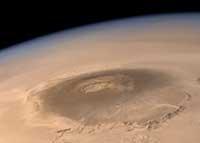
Olympus Mons, biggest volcano in the solar system. Credit: Justin Cowart, CC BY-SA
Unveiling the red planet’s mysteries
Scientists, including one from Lawrence Livermore. have used meteorites fallen to Earth to recreate the evolution of a volcano on Mars, in a first-ever attempt made in history.
They discovered that Martian volcanoes were bigger, scarier and grew a thousand times slower than those on Earth.
The space rocks hid more than 90 million years of information on the red planet's volcanoes. They allowed scientists to identify from which volcano they came from, how fast it grew and how long it was active.
Mars has the largest volcanoes in the solar system. Olympus Mons is more than 370 miles wide and more than 13 miles high, more than twice the height of Mount Everest, the tallest mountain on Earth.

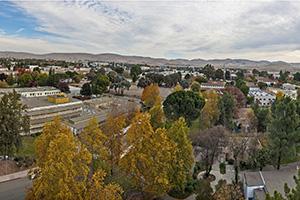
Lab Report takes a break
The Lab Report will take a break for the holidays. It will return Jan. 12.
Lab Report staff sends well wishes for the New Year to its loyal readers.





